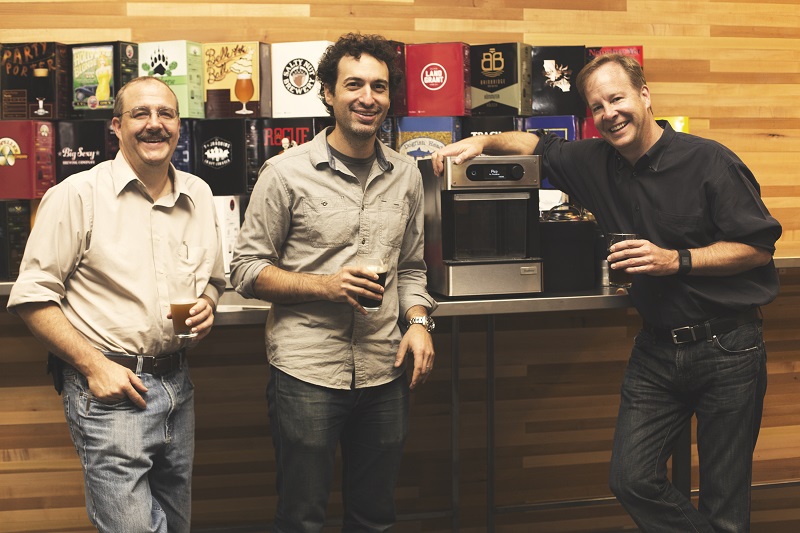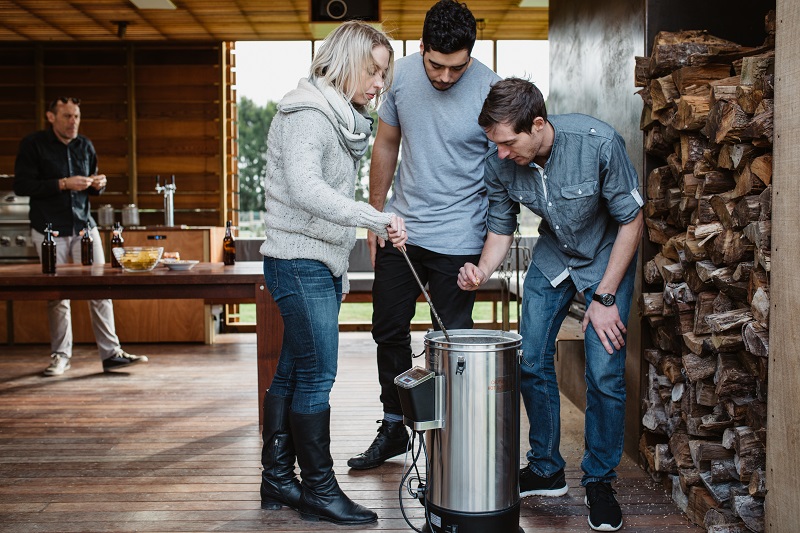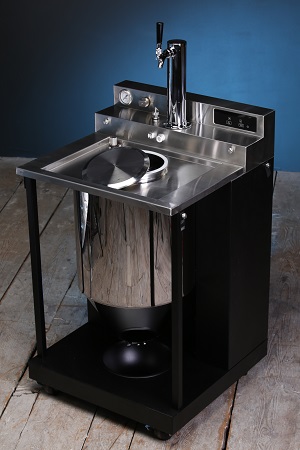Automated Homebrewing Systems Flood Market
Carboys, airlocks, racking canes, siphons … just reading through a list of tools needed for conventional homebrewing can be deterrent enough for some considering the hobby.
Add the lengthy process of sanitizing each constituent piece before getting to the “fun” stuff, the manual labor involved in hauling 30- and 40-pound buckets to and fro, and the unavoidable wreck of any room in which you choose to homebrew, and it becomes very apparent why plenty of people who love beer demur from making their own—or try homebrewing, but only once.
An emerging series of automated brewing devices, though, is bringing down those barriers. And as a testament to how desirable these machines are, their manufacturers raised over $2 million in crowdsourcing campaigns to date. The systems may appeal to novices or master homebrewers.
Drew Beechum and Denny Conn are co-authors of the books Homebrew All-Stars and Experimental Homebrewing—Mad Science in the Pursuit of Great Beer. They also run the “Experimental Brewing” podcast and blog. Both have homebrewed for roughly 18 years and are well-versed in the labors of conventional brewing. And both also regularly use the Zymatic automated brewing device made by PicoBrew out of Seattle, where they have featured recipes.
“I’ve heard people say, ‘Oh the Zymatic, that’s not really brewing,’” says Conn. “Who the hell are you to try and tell me what brewing is?”
Beechum echoes Conn.
“There are some people out there who would look at anything short of how they did it 300 years ago with manual labor and sweat dripping into the beer as not being real brewing,” Beechum says.
Critics may have a hard time faulting the Zymatic out of anything but philosophy, for the machine is one of the more brewer-directed automated brewing devices on the spectrum. Users can select from a bevy of preprogrammed recipes drafted by 2013 American Homebrewers Association Homebrewer of the Year Annie Johnson or create their own for the system—setting mash and boil types, rates, timings and hop additions.
After inserting their choice of grain and hops (up to four types of hops, and each can be programmed for separate additions), homebrewers can walk away from the machine. Via internet and smart devices, the Zymatic provides updates on the “vital statistics” of the beer—graphical representations of time and temperature—as it brews. Users only have to return to pitch yeast and then ferment the beer in a keg.
“I’m not a process guy … I’m more sort of flavor- and culinary-motivated in terms of my brewing,” says Beechum. “The Zymatic is perfect for me because it allows me to still brew while I’m doing 5,000 other things, but it still allows me to make a product that I really like.”
Conn loves the machine’s ability to control for variables so that he can methodically test the effects of slight changes in a recipe, from yeast strains to hops.
“What I like about the Zymatic is it makes things absolutely repeatable,” says Conn.
Though PicoBrew (of which ZX Ventures, a venture capital team backed by Anheuser-Busch InBev, has a minority stake) sponsors the pair’s podcast, both hosts insist that the relationship came after they tried and fell for the Zymatic on their own accord. Conn says the two had no interest in the device at first. “After I tried it, I became addicted,” he says.
Ray Daniels, founder and director of the Cicerone Certification Program and a contributor to All About Beer Magazine, is a little more skeptical of such systems.
“I brewed four batches with [the Zymatic] in February last year and didn’t really find the results to my liking,” he says. Daniels admits, however, to modifying the setup to his own specs, adding a long downtube on the “return” side of the keg to try to reduce aeration.
“I certainly wouldn’t praise it, but I’d also be reluctant to damn it on the basis of my experience alone,” he adds, noting that a friend homebrews on it “fine.” (As an unadvertised bonus, the friend also successfully cooks sous vide in the machine.)

The Pico from PicoBrew retails for $799. (Photo courtesy PicoBrew)
PicoBrew’s latest machine, the Pico, is for enthusiasts who want less to do with the brewing process and don’t care to pay $1,999 for the Zymatic. The machine comes purchasable with sets of ingredient cartridges (PicoPaks) that correspond to preloaded recipes, some of which come from a bevy of well-known brewers that include Dogfish Head Craft Brewery and Abita Brewing Co. Others come from established homebrewers that include Conn and Beechum.
With the Pico, all homebrewers have to do is put in the PicoPak and add water to brew. Then, as with the Zymatic, pitch in yeast and transfer the beer to a serving keg afterward (fermentation takes place under pressure within the Pico to abbreviate the process). The device lists at $799. The Pico device raised more than $1.4 million on Kickstarter in November 2015, and the first devices recently began shipping to backers.
The Brewie, based out of Hungary, is another automated brewing system that also had a successful crowdfunding campaign, raising $719,922 on Indiegogo by February 2015. It lies somewhere between the Pico and the Zymatic in terms of user direction, though the Brewie sort of falls more on the latter’s side.
“We were shocked how crazy everyone got about the idea,” says Mark Schiller, former marketing manager for Brewie.
With the Brewie, users can brew preloaded recipes that correspond to prepackaged Brewie Pad ingredients or input their own recipes and/or ingredients. And, like the Zymatic and Pico systems, Brewie is compatible with smartphones. Via Brewie’s social platform, brewers can connect to exchange recipes, organize events and share brewing experiences.
So far the 600-plus pre-ordered Brewies are scheduled to start going out this year—almost two years after the close of its crowdfunding campaign and numerous delays. Schiller says this lapse resulted from the company’s decision to improve the machine before distribution. Some of the updates the Brewie has undertaken: improved heating and cooling capabilities and four automated hop additions (rather than the original two).
The Brewie lists for $2,199, but for 2016 its price hovered at a cool $1,899.

The Grainfather is one of the most manual of the automated homebrew devices on the market. (Photo courtesy Grainfather)
Swinging away from the PicoBrew paradigm, the Grainfather is one of the most manual of the devices on the market. Listing at $890, the system, which comes from New Zealand, basically combines multiple parts of the homebrewing process—pots, siphons, strainers, filters, etc.—into one machine.
Recipes for the Grainfather are not preloaded. And though mashing and boiling temperatures are controlled digitally, timings, sparging and hop additions are not.
With the Grainfather, a homebrewer can’t just put in the ingredients and walk away like with the Zymatic and the Brewie, though a Bluetooth control box update for the machine allows partial automation. Ingredient kits and recipes available for the machine were developed in coordination with New Zealand breweries such as Panhead Custom Ales, North End Brewing Co., Behemoth Brewing Co. and Fork Brewing.
“It’s perfect for advanced and novice brewers,” says Kelsey Davis, a representative for the Grainfather. “Advanced [homebrewers] have the opportunity to be creative and involved in the process, but it’s simple and easy to use for newbies, too.”
Twelve thousand Grainfather systems had been sold as of summer 2016, after its inception in August 2014.
Big companies, too, are working to cash in on the heightened consumer interest in automated homebrewing machines. SodaStream’s recently announced “Beer Bar” combines carbonated water with beer “concentrates” to “brew” beer. And Whirlpool Corp., best known for its kitchen and laundry appliances, placed its new Vessi device on Indiegogo in May.

The Vessi doesn’t brew beer, but it does ferment, carbonate and dispense beer. (Photo courtesy Whirlpool Corp.)
Headed up in development by Whirlpool Corp. master model maker and homebrewing enthusiast Bob Schneider, the Vessi isn’t a brewing system but a fermentation system. All the pots and pans and siphons for brewing—those are still on the consumer to provide. But the Vessi does carbonate and fully ferment beer, and does so with temperature and pressure controls, as well as the ability to clear sediment. It also dispenses beer and can bottle or keg beers to accommodate more than one batch.
For a simple picture: Think of Vessi as the fanciest kegerator you’ve ever seen (or rather, a kegerator fused with a temperature- and pressure-controlled carboy).
Early bird specials on Indiegogo offered the device for $1,399. It is currently priced at $1,899. “If the consumer tells us we’re crazy, we could adjust,” says Noel Dolan, senior manager behind the project.
When asked why a company with $20.9 billion in annual revenue would turn to crowdfunding, Nolan says it gives Whirlpool Corp. an “opportunity to validate that there is a market out there of consumers who want it [the Vessi].”
As of January 2017, the Vessi’s campaign had raised more than $240,000, far in excess of its original $100,000 goal. The campaign is listed as “flexible,” meaning Whirlpool receives all funds raised for the device, regardless of whether they fall above or below the crowdfunding goal. Early donors of $1,399 will receive the device itself, as will later donors of $1,899 or more. Whirlpool Corp. began delivering devices ordered through the campaign in December.
Editor’s Note: This story is part of a special section on the future of beer, which appears in the March 2017 issue of All About Beer Magazine.
Bo McMillan
Bo McMillan is a writer/proud nerd who lives in Chicago.

Leave a Reply